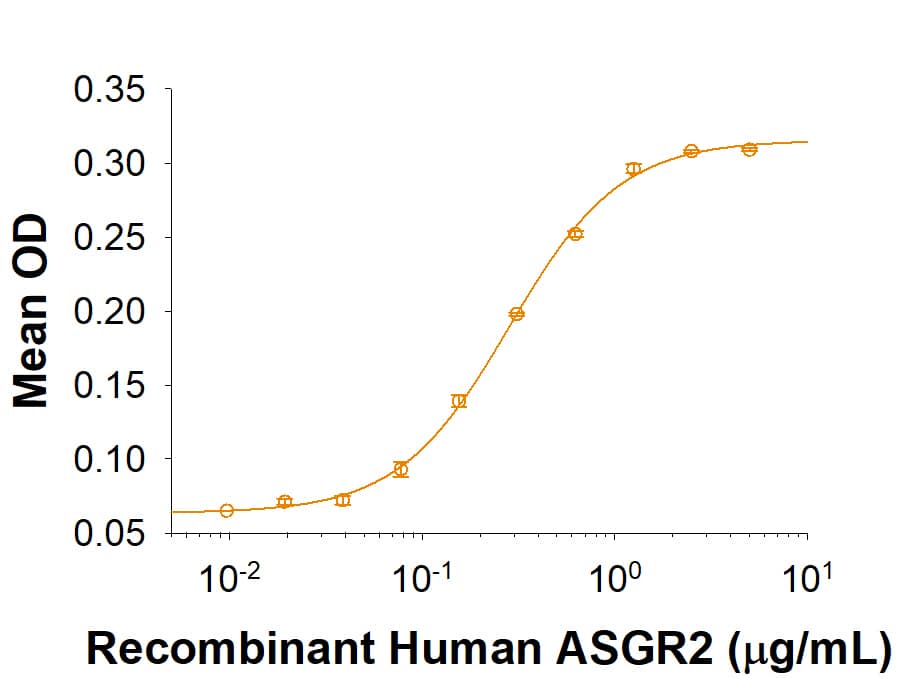Recombinant Human ASGR2/ASGPR2 Fc Chimera Protein, CF Summary
Product Specifications
| MD | Human IgG1 (Pro100-Lys330) | IEGR | Human ASGR2/ASGPR2 (Gln80-Ala311) Accession # NP_001172 |
| N-terminus | C-terminus | ||
Analysis
Product Datasheets
Carrier Free
CF stands for Carrier Free (CF). We typically add Bovine Serum Albumin (BSA) as a carrier protein to our recombinant proteins. Adding a carrier protein enhances protein stability, increases shelf-life, and allows the recombinant protein to be stored at a more dilute concentration. The carrier free version does not contain BSA.
In general, we advise purchasing the recombinant protein with BSA for use in cell or tissue culture, or as an ELISA standard. In contrast, the carrier free protein is recommended for applications, in which the presence of BSA could interfere.
9370-AS
| Formulation | Lyophilized from a 0.2 μm filtered solution in PBS. |
| Reconstitution | Reconstitute at 500 μg/mL in PBS. |
| Shipping | The product is shipped at ambient temperature. Upon receipt, store it immediately at the temperature recommended below. |
| Stability & Storage: |
|
Scientific Data
 View Larger
View Larger
Immobilized Recombinant Human ASGR2 Fc Chimera binds human plasma von Willebrand Factor with an ED50 of 0.15-0.9 μg/mL.
Reconstitution Calculator
Background: ASGR2
Asialoglycoprotein receptor 2 (ASGR-2), also known as C-type lectin domain family 4 member H2 (CLEC4H2) and hepatic lectin H2 (HL-2), is an approximately 48 kDa member of the C-type lectin receptor family (1, 2). ASGR-2 is a single-pass type II transmembrane protein that plays a role in the endocytosis of desialylated glycoproteins and hepatic thrombopoietin production (3). ASGR-2 is closely related to ASGR-1 which is about 2 kDa smaller and is encoded by distinct but closely linked genes. Variations in ASGR-2 structure due to alternative splicing have been reported (4-6). Mature ASGR-2 consists of a 5 amino acid (aa) cytoplasmic domain, a 21 aa transmembrane segment and a 232 aa extracellular domain (ECD). Within the ECD, human ASGR-2 shares 66% and 62% aa sequence identity with mouse and rat ASGR-2, respectively. Both ASGR-2 and ASGR-1 compose the asialoglycoprotein receptor (ASGPR) which mediates removal of potentially hazardous glycoconjugates from blood in health and disease (7). ASGPR, also known as the Ashwell receptor, can modulate von Willebrand factor (vWF) and platelet homeostasis in part through clearance of platelets that are first desialylated during sepsis caused by pathogens including S. pneumoniae. The ASGR-1 chain of the Ashwell receptor can also participate in plasma vWF clearance independently of sialylation and sepsis, ASGR-2 colocalization with plasma vWF was increased in ASGR-1 deficient mice (8). In addition, ASGR-2 expression was shown to be associated with malignant phenotypes in gastric cancer and may represent a specific biomarker for recurrence of some gastric cancers (9).
- Spiess, M. and H.F. Lodish. (1985) Proc Natl Acad Sci U.S.A. 19: 6465.
- Grewal, P.K. (2010) Methods Enzymol. 479:223.
- Grozovsky, R. et al. (2015) Nat Med. 1:47.
- Drickamer, K. et al. (1984) J. Biol. Chem. 259:770.
- Halberg, D.F. et al. (1987) J. Biol. Chem. 262:9828.
- Paietta, E. et al. (1992) J. Biol. Chem. 267:11078.
- Harris R.L. et al. (2012) Mol Biol Int. 2012:283974.
- Grewal, P. et al. (2008) Nature Medicine. 14:6.
- Tanaka H. et al. (2018) Mol Cancer Res. doi: 10.1158/1541. MCR-17-0467. [Epub ahead of print].
FAQs
No product specific FAQs exist for this product, however you may
View all Proteins and Enzyme FAQsReviews for Recombinant Human ASGR2/ASGPR2 Fc Chimera Protein, CF
There are currently no reviews for this product. Be the first to review Recombinant Human ASGR2/ASGPR2 Fc Chimera Protein, CF and earn rewards!
Have you used Recombinant Human ASGR2/ASGPR2 Fc Chimera Protein, CF?
Submit a review and receive an Amazon gift card.
$25/€18/£15/$25CAN/¥75 Yuan/¥1250 Yen for a review with an image
$10/€7/£6/$10 CAD/¥70 Yuan/¥1110 Yen for a review without an image
